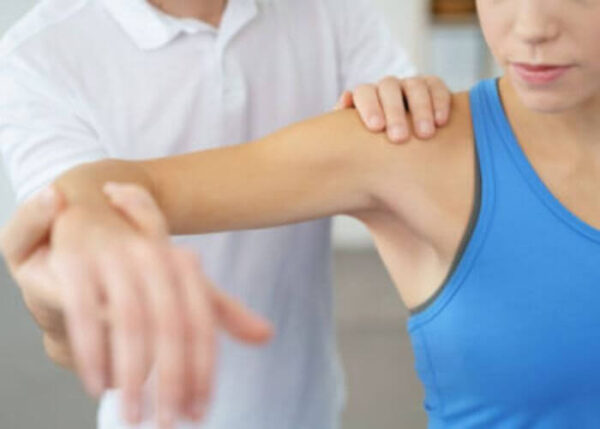Shoulder Arthritis Specialist

Are you an athlete who is experiencing pain and decreased range of motion while participating in overhead sports? Repetitive overhead motions can lead to the development of glenohumeral arthritis. Dr. Matthew Provencher, Vail area orthopedic shoulder surgeon, helped pioneer arthroscopic shoulder surgery techniques designed to provide an alternative treatment option for glenoid arthritis. Contact Dr. Provencher’s team today!
What are Biologic Shoulder Replacement Options?
Chondral injuries of the glenohumeral joint are quite common and well tolerated in many patients, but young, active patients may suffer from pain and decreased range of motion in some cases. The glenohumeral joint is a ball and socket joint found within the shoulder and is formed by the connection of the humerus (upper arm bone) head and the cup-like structure of the scapula (shoulder blade). The glenohumeral joint typically functions with a wide range of motion. When the articular surfaces of the joint become damaged, patients often experience pain and loss of motion with the development of glenohumeral arthritis. Many cases of glenohumeral arthritis are treated with an arthroplasty (replacement) procedure, but that is not an appropriate treatment option for young patients with a limited extent of glenoid arthritis. Because of this, Dr. Matthew Provencher, Vail, Aspen, Colorado Springs and Denver, Colorado area orthopedic shoulder surgeon, helped pioneer arthroscopic shoulder surgery techniques designed to provide an alternative treatment option for glenoid arthritis.
A total shoulder replacement (arthroplasty) has always provided orthopedic surgeons with a predictable result in terms of pain relief and function associated with glenohumeral arthritis. However, symptomatic cartilage injuries in young patients create a challenge since traditional shoulder replacement surgery is not ideal in a younger age group.
Dr. Provencher and a team of leading orthopedic surgeons developed novel arthroscopic shoulder surgery techniques designed to be a shoulder replacement alternative. Dr. Provencher will determine the correct minimally invasive treatment based on the patient’s age, activity level, extent of injury and occupation.

What are Arthroscopic Techniques for Glenohumeral Arthritis?
- Debridement – Debridement is an ideal minimally invasive procedure in lower-demand patients with a well-contained, small lesion, as well as younger patients who are not candidates for traditional replacement surgery. During debridement, Dr. Provencher will remove areas of damaged and inflamed cartilage to create a smooth surface.
- Glenoid Microfracture – The goal of glenoid Microfracture is similar to knee Microfracture, to create tiny holes in the bone in the injured area to release marrow. The marrow will create a new layer of fibrocartilage over the glenoid head and replace the damaged cartilage.
- Glenoid reconstructive treatment – Glenoid reconstructive treatment is designed to re-establish bone and cartilage on the glenoid (socket of the ball and socket shoulder joint, part of the shoulder blade) with an osteochondral allograft (donor tissue), or bone autograft (patient derived tissue) or transfer. This is especially indicated in patients that in addition to experiencing glenohumeral arthritis are also having chronic anterior or posterior instability (subluxations and dislocations) due to bone loss. This technique innovatively utilizes fresh osteochondral allograft from the distal tibia (lower shin bone portion of the ankle joint) in a procedure first designed by Dr. Provencher that has been adopted by the field of orthopedics as a reliable treatment option for glenohumeral bone loss. Alternatively, an autograft can be used to replenish the glenoid bone harvested from the iliac crest (upper hip bone) or the coracoid process (a small bony projection that is part of the upper neck of the shoulder blade) can be transferred and grafted onto the affected shoulder in a technique called the Latarjet Procedure. The most appropriate approached will be determined by Dr. Provencher based on the physical examination and imaging findings on a case-by-case basis.
- Humeral reconstructive treatment– Humeral reconstructive treatment is designed to re-establish cartilage and bone on the humeral (upper arm bone) head with an osteochondral allograft (donor tissue). The overall goal of reconstructive treatment is to biologically restore the articular surface of the humerus with fresh osteochondral allograft plugs from either the humeral head or talus (ankle bone). Dr. Provencher typically utilizes a talus allograft since it is readily available. This treatment option remains one of the most versatile options for large defects that are extensive and uncontained.
- Treatment combinations – Some cases may necessitate the employment of various techniques, at times even combinations of biologic reconstruction and prosthetic implantation, as in cases calling for the use of shoulder hemiarthroplasty, where the humeral head (ball of the ball and socket shoulder joint, part of the upper arm bone) is replaced with a prosthetic while the native glenoid socket is left intact, in combination with biologic bone grafts to replenish the native glenoid bone depletion.
What is the Recovery Following Arthroscopic Shoulder Surgery for Glenohumeral Arthritis?
Recovery and rehabilitation following an alternative arthroplasty procedure for glenohumeral arthritis is an important aspect of the overall success. Depending on the arthroscopic shoulder surgery technique performed by Dr. Provencher, patients will begin a strict physical therapy program aimed at encouraging full range of motion and strengthening. It is strongly suggested that patients work with the in-house physical therapists at Howard Head Sports Medicine to optimize their rehabilitation. Dr. Provencher and his orthopedic team will guide each patient through the correct rehabilitation program following surgery.
For more resources on arthroscopic shoulder surgery techniques designed for glenohumeral arthritis, please contact the orthopedic practice of Dr. Matthew Provencher, shoulder surgeon serving patients in the Vail, Aspen, Colorado Springs and Denver, Colorado area.